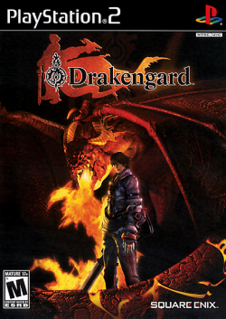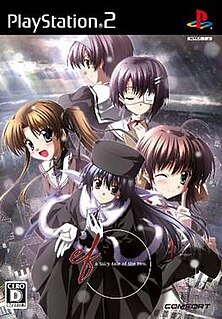 W
WDrakengard, known in Japan as Drag-On Dragoon, is a 2003 action role-playing video game developed by Cavia and published by Square Enix for the PlayStation 2. The game is the first installment of the Drakengard series and features a mixture of ground-based hack-and-slash, aerial combat, and role-playing elements which have become a staple of the series. The story is set during a religious war between two factions—the Union and the Empire—with the war tipping in favor of the Empire. The player controls Caim, a deposed prince of the Union, in his quest for vengeance against the Empire. Wounded in battle while protecting his sister Furiae, he is forced to make a pact with a red dragon named Angelus. As they journey together, they join with Hierarch Verdelet on a quest to prevent the Empire from destroying magical seals that keep the world in balance: Furiae acts as the central seal, and her death will drop the world into chaos.
 W
WDrakengard 3, known in Japan as Drag-On Dragoon 3, is an action role-playing video game developed by Access Games and published by Square Enix exclusively for PlayStation 3. It is the third game in the Drakengard series and a prequel to the original game. The game, like the rest of the series, features a mixture of ground-based hack-and-slash combat and aerial battles. The story focuses on Zero, a woman who can manipulate magic through song. Partnering with a dragon named Mikhail, Zero set out to kill her five sisters, who rule the world's regions. As she travels, the player discovers the true reason behind Zero's rampage.
 W
WEf: A Fairy Tale of the Two is a Japanese two-part adult visual novel series by Minori for Windows PCs. The first game in the series, Ef: The First Tale, was released on December 22, 2006, and the second game, Ef: The Latter Tale, was released on May 30, 2008. The opening video for the game was animated by Makoto Shinkai, and a majority of the music was produced by Tenmon, who has worked in the past with Shinkai and Minori. Female character design was by Naru Nanao of Da Capo fame, while male character design was by 2C Galore.
 W
WFatal Frame III: The Tormented is a Japanese survival horror video game developed and published by Tecmo in 2005 for the PlayStation 2. It is the third installment in the Fatal Frame series. The story follows Rei Kurosawa, a freelance photographer who has been tasked with taking photos of an abandoned manor. After she spots an apparition of her fiancé she recently lost in a car crash, events quickly take a paranormal turn as she begins to explore the manor in her dreams and learns of its connection to those suffering from survivor's guilt.
 W
WZero: Tsukihami no Kamen is a survival horror video game primarily developed by Tecmo and published by Nintendo for the Wii video game console; Tecmo shared development with Nintendo SPD and Grasshopper Manufacture. The fourth installment in the Fatal Frame series and the first on a Nintendo console, it was released in Japan on July 31, 2008. Despite a European release being announced, the game has never been released outside of Japan. A fan translation was released in 2010.
 W
WFinal Fantasy X is a role-playing video game developed and published by Square as the tenth main entry in the Final Fantasy series. Originally released in 2001 for PlayStation 2, the game was re-released as Final Fantasy X/X-2 HD Remaster for PlayStation 3 and PlayStation Vita in 2013, for PlayStation 4 in 2015, Microsoft Windows in 2016, and for Nintendo Switch and Xbox One in 2019. The game marks the Final Fantasy series transition from entirely pre-rendered backdrops to fully three-dimensional areas, and is also the first in the series to feature voice acting. Final Fantasy X replaces the Active Time Battle (ATB) system with the "Conditional Turn-Based Battle" (CTB) system, and uses a new leveling system called the "Sphere Grid".
 W
WKamen Rider Hibiki is a Japanese tokusatsu superhero television series, serving as the fifteenth installment in the popular Kamen Rider Series of tokusatsu programs. It is a joint collaboration between Ishimori Productions and Toei. Kamen Rider Hibiki first aired on January 30, 2005 and aired its final episode on January 22, 2006.
 W
WKuon is a 2004 survival horror video game developed by FromSoftware for the PlayStation 2. Published by FromSoftware in Japan, it was released in North America by Agetec, and in Europe by Nobilis and Indie Games Productions in 2006. The narrative takes place in Japan's Heian period, and follows the actions of three protagonists during an outbreak of monsters at Fujiwara Manor in Kyoto; Utsuki, daughter of the onmyōji Ashiya Doman, Doman's apprentice Sakuya, and the veteran onmyōji Abe no Seimei. Gameplay has the different characters exploring the grounds and buildings of Fujiwara Manor, solving puzzles and fighting off hostile monsters.
 W
WThe music of Middle-earth consists of the music mentioned by J. R. R. Tolkien in his Middle-earth books, the music written by other artists to accompany performances of his work, whether individual songs or adaptations of his books for theatre, film, radio, and games, and music more generally inspired by his books.
 W
WThe Pied Piper of Hamelin is the titular character of a legend from the town of Hamelin (Hameln), Lower Saxony, Germany. The legend dates back to the Middle Ages, the earliest references describing a piper, dressed in multicolored ("pied") clothing, who was a rat-catcher hired by the town to lure rats away with his magic pipe. When the citizens refuse to pay for this service as promised, he retaliates by using his instrument's magical power on their children, leading them away as he had the rats. This version of the story spread as folklore and has appeared in the writings of Johann Wolfgang von Goethe, the Brothers Grimm, and Robert Browning, among others.
 W
WThe Place Promised in Our Early Days is a 2004 Japanese anime film written, directed, produced, cinematographed, edited, and storyboarded by Makoto Shinkai in his feature film debut. Set over several years in an alternate history where the Soviet Union occupies half of Japan, the film follows two childhood friends who grow apart after one of their friends disappears; as international tension rises and a mysterious tower built by the Union starts replacing matter around it with matter from other universes, they cross paths once again and realize their missing friend might be the key to save the world.
 W
WThe Rhythm of Fighters was a free-to-play music-based video game produced and developed by SNK Playmore for iOS and Android. It was released on June 24, 2014 and removed from app stores on July 15, 2015. In the game, the player controls a fighter and taps the screen to attack a rival. Depending on the character chosen, a different musical theme would be used. Additionally, the player can earn experience by defeating enemies similar to role-playing video games.
 W
WSpirit Camera: The Cursed Memoir is a spin-off game in the Fatal Frame series, co-developed by Tecmo Koei and Nintendo for the Nintendo 3DS. The game comes with an "AR notebook", the titular Diary of Faces, which the player uses in conjunction with the game. It was released in 2012 for Japan on January 12; in North America on April 13; and in Europe on June 29.
 W
WTheatrhythm Final Fantasy is a rhythm video game, developed by indieszero and published by Square Enix for Nintendo 3DS and iOS. Based on the Final Fantasy video game franchise, the game involves using the touch screen in time to various pieces of music from the series. The game was released in Japan in February 2012, and in North America, Australia and Europe in July 2012. An iOS version was released in December 2012. A sequel, Theatrhythm Final Fantasy: Curtain Call, was released in 2014. A third game based on the Dragon Quest series, Theatrhythm Dragon Quest, was released in 2015. An arcade game, Theatrhythm Final Fantasy: All-Star Carnival, was released in 2016.
 W
WTheatrhythm Final Fantasy: Curtain Call is a rhythm video game. A sequel to the 2012 video game Theatrhythm Final Fantasy and the second title in the rhythm series, it features similar gameplay to its predecessor. It was released for the Nintendo 3DS on April 24, 2014 in Japan, on September 16, 2014 in North America, on September 18, 2014 in Australia, and in Europe on September 19, 2014.
 W
WThe Young Unicorns (1968), ISBN 0-374-38778-8) is the title of a young adult suspense novel by Madeleine L'Engle. It is the third novel about the Austin family, taking place between the events of The Moon by Night (1963) and A Ring of Endless Light (1980). Unlike those two novels and Meet the Austins (1960), it does not center on Vicky Austin specifically, but on a family friend, Josiah "Dave" Davidson.